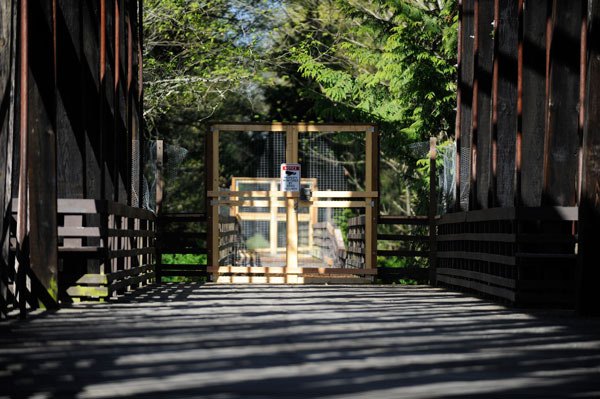The damaged trestle that once allowed passage across the Dungeness River at Railroad Bridge Park and served as a critical piece of the Olympic Discovery Trail could be replaced with a modern, river- and fish-friendly bridge by the end of the year.
Ideally, construction would begin the end of August and finish mid December, according to Annette Nesse, chief operations officer for Jamestown S’Klallam Tribe.
The property, along with its structures, are owned by the Jamestown S’Klallam Tribe.
If the trestle compromised in early February by heavy rains that caused rapid currents, high flows and loose debris is replaced, Nesse assures the historic and undamaged, 150-foot bridge would remain.
Whether the tribe pursues replacement or opts for a temporary fix is still funding dependent, but the tribe is “strongly leaning toward a permanent replacement,” Nesse said. However, a final funding estimate from the engineer is still needed.
Although the bulk of the construction cost estimated in May at $1.8 million is seemingly secured following the state budget approved late June by Legislature after multiple extensions, Nesse said the tribe will continue to look for “gap” funding.
Cheryl Baumann, North Olympic Lead Entity for Salmon coordinator, said her organization anticipates receiving enough of a funding allocation from the Puget Sound Acquisition and Restoration and Salmon Recovery Funding Board to provide the $1.53 million requested for the Dungeness River Railroad Reach Floodplain Restoration for replacement of the west side trestle.
The North Olympic Lead Entity for Salmon is a consortium of area tribes, other governments, citizens and nonprofit groups that work to identify which local projects are forwarded for funding.
“The Washington State Legislature approved monies for those funding sources on June 30; however, we are awaiting confirmation from the Puget Sound Partnership and the Salmon Recovery Funding Board of our exact allocation amount,” Baumann said.
Locally, the project to replace the damaged trestle ranked third among five projects the Lead Entity is seeking funding for.
The trestle replacement project is expected to benefits salmon given it removes numerous creosoted pilings and fill which constrain the river’s path and prevent healthy floodplain processes, according to Baumann. It’s also part of a larger effort to restore the Dungeness River and recover Puget Sound chinook – a specie listed under the federal Endangered Species Act.
With the extremely low river flows coupled with a large forecast of pink salmon, it’s “timely” the flooding earlier in the year caused damage to the trestle, requiring the tribe to replace it with a bridge better designed for fish and one that allows “the river breath way it should,” Ron Allen, Jamestown S’Klallam Tribal Council chairman told those attending the tribe’s Salmon Homecoming Ceremony, July 11.
Beyond the funds
Although needed funding was approved by state Legislature to the appropriate organizations to allow for the allocation of construction funds, replacement of the trestle with a river-wise bridge now awaits approval by the Salmon Recovery Funding Board’s Review Panel.
The review panel met July 14.
“We could know their decision right away or it could take a couple weeks,” Baumann said.
While tribe officials wait for the panel’s feedback on a design developed by Otak, an integrated architecture firm based in Redmond, they’ll continue to move forward with the permitting process to do work in and around the river.
“Permitting is another big challenge,” Nesse said. “So far, all entities have been very responsive in trying to help us to meet our construction schedule.”
The design chosen by tribal officials has few piers in contrast to the existing trestle and calls for primarily steel and concrete building material instead of treated wood. Piers are anticipated to be arranged 180-feet apart, with the exception of one 30-foot span to allow for an observation area.
Other Dungeness River work
As another result of the recently approved funds in the capital budget, the Department of Ecology indicated that the levee setback restoration effort also underway on the Dungeness River will receive construction funding from the Floodplains by Design program, Baumann said.
“The Lower Dungeness River Floodplain Restoration and Levee Setback requested $9,501,600 from the Floodplains by Design Program,” she said. “It competed against 71 other projects in the state and was the third-ranked project overall in that process.”
The funding will allow county officials as the lead on the project to move “seamlessly” from the design phase, beginning later this year into the construction phase of the “important” restoration project, Cathy Lear, Clallam County habitat biologist, said.
“The County and its partners appreciate the legislative support that we have received for restoring the Dungeness floodplain,” Lear said.



